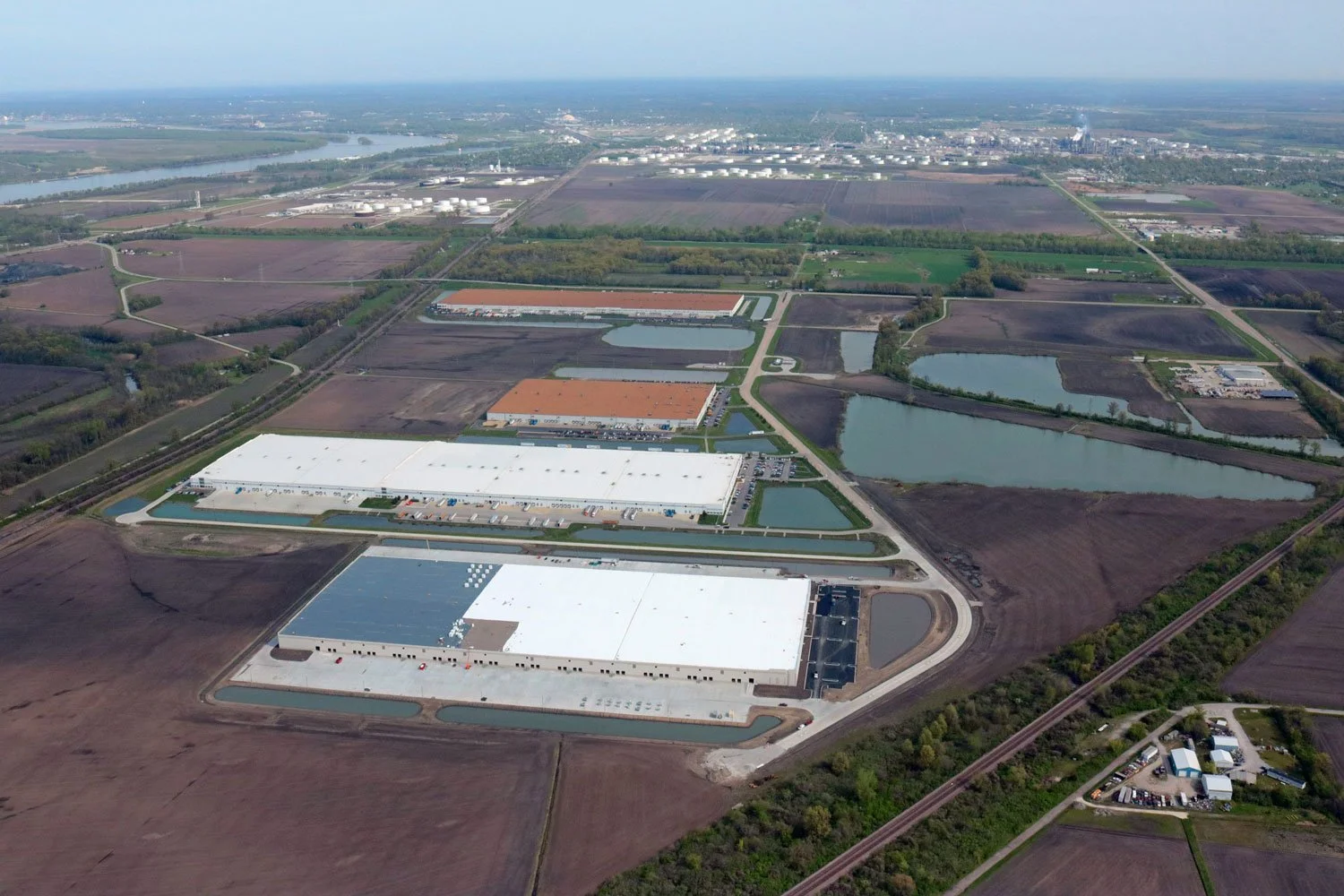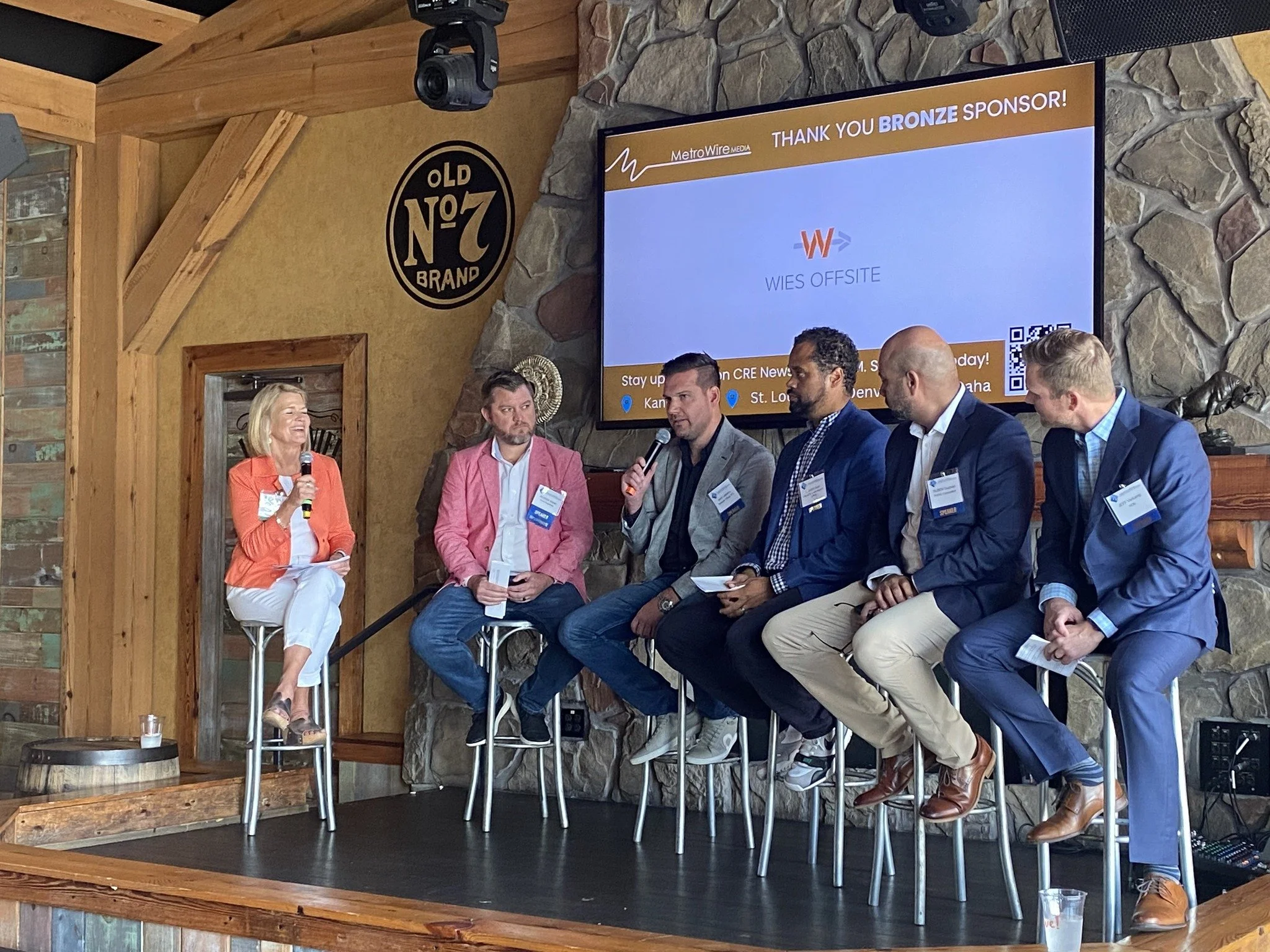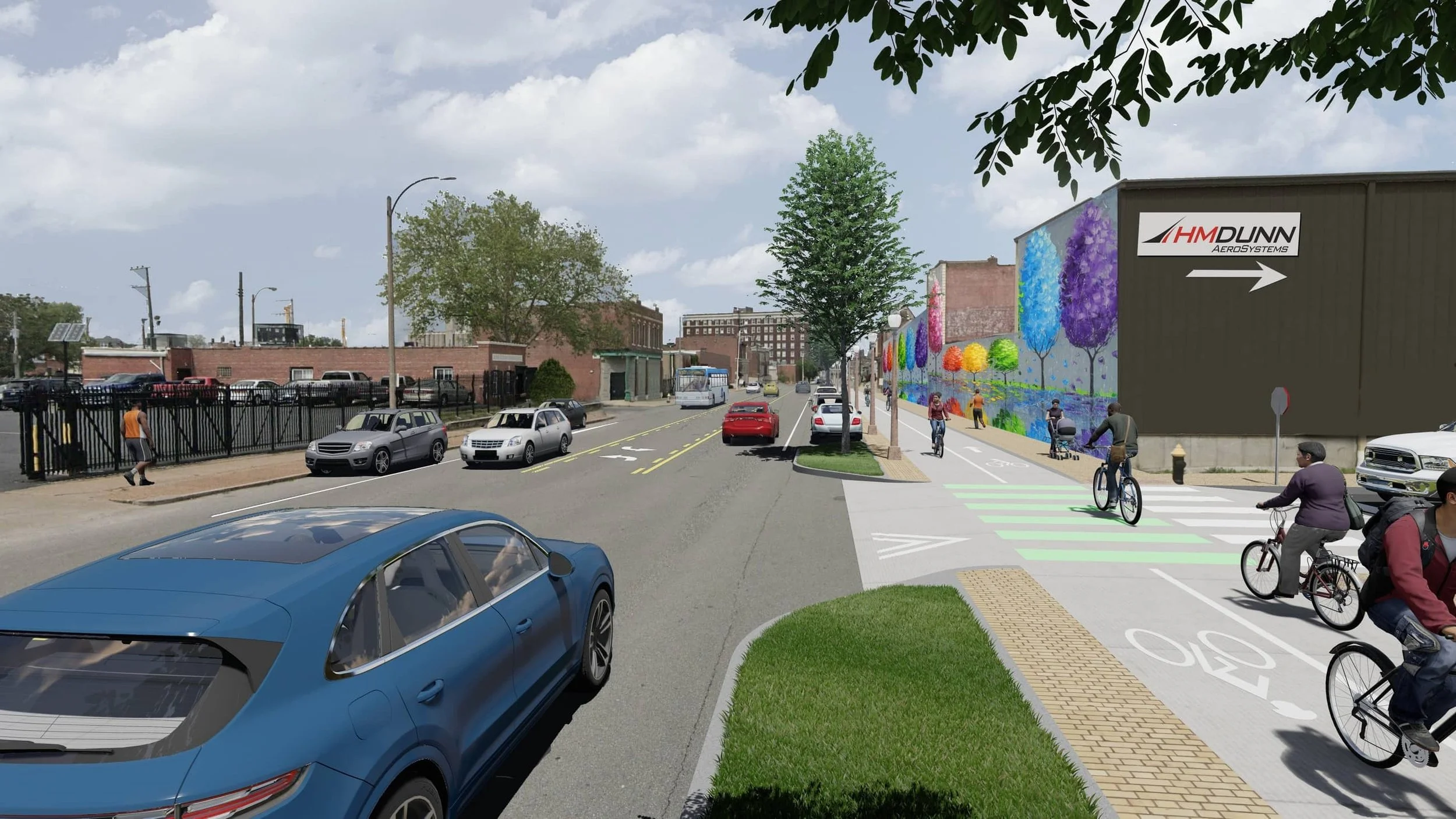Photo credit: Drew Edelstein, Lawrence Group
Sealy & Co. renews 1.6M SF lease with World Wide Technology in Edwardsville
Sealy & Co. has secured a lease renewal for two buildings with World Wide Technology (WWT) at Lakeview Commerce Center II and III in Edwardsville, Ill., covering in excess of 1.6 million SF. WWT, the company’s largest tenant, has maintained a long-term relationship with Sealy.
Lakeview Commerce Center II, located at 3971 Lakeview Corporate Dr., comprises 539,877 SF and includes a variety of enhancements. The facility, which was delivered in 2006, features 29,900 SF of office and laboratory space, T5 specialty lighting, and generators for emergency backup.
Lakeview Commerce Center III, a distribution center located next door, encompasses the bulk of the square footage with 1,109,830 SF. Originally completed in 2008, it was expanded in 2015 to add more office space, custom trailer stalls, and enhanced security measures. This building also recently earned the BOMA 360 designation for its high standards in energy efficiency, safety, security, and tenant relations.
Both properties are ideally located in the Metro East industrial submarket of St. Louis, just west of Hwy. 111, with direct access to I-270 and downtown St. Louis only 20 miles down the road.
Negotiations for the renewal were led by Sealy’s Regional Director William Shagets, with support from Cushman & Wakefield’s Ed Lampitt and Matt Eastin.
The St. Louis industrial market continues to see strong leasing activity through the third quarter of 2024 with a vacancy rate of 4.7%, according to a CBRE report (St. Louis Industrial Figures Q3 2024). Leasing activity surpassed 1.2 million SF, up 24% from the previous quarter. While the Metro East submarket had the second-highest vacancy rate in the area just under 10%, it led the region in leasing activity with 414,000 SF for the quarter.
Header image: Lakeview Commerce Center puchased by Sealy & Co. in 2020 is located just 20 miles from downtown St. Louis in Edwardsville, Ill. Image courtesy of St. Louis Regional Freightway
Forsythia on the Park: $36M luxury condominium development underway in Clayton
Past meets present in St. Louis' adaptive reuse odyssey
Amidst the lively ambiance of Alamo Drafthouse within City Foundry STL, industry leaders convened for the MWM STL 2024 Adaptive Reuse & Redevelopment event on May 8, 2024.
The 15-acre site is a prime example of innovative adaptive reuse and redevelopment, featuring many diverse entertainment spaces, retail outlets, and nearly completed apartments with attached garages. The dynamic mixed-use project includes attractions beyond the Alamo Drafthouse; including Puttshack golf, a clandestine speakeasy, an immersive Sandbox VR experience, retail shops, its own Food Hall consisting of 17 restaurants, City Winery and more.
It was home to the Midtown St. Louis manufacturing hub and then purchased by the Century Electric motor manufacturing company almost 100 years ago. Work continued on a nearly 24-hour basis until 2007.
The event included a chance to see such projects in real-time through a tour of One Foundry Way, led by Todd Rogan of Lawrence Group.
Alice Benner, COO of Artori Group, moderated insights from Sam Adler, director of development, New + Found; Joel Fuoss, AIA, IIDA, LEED AP, principal, Trivers; Greg Gleicher, founder, Good Developments Group; Michael Hamburg, owner, Pier Property Group; Jassen Johnson, founder, Onyx Development; and Matthew Stack, president-St. Louis, Russell.
“The number of buildings going from office to apartments is increasing across the country,” Benner said. Reuse and redevelopment can be key to reviving both neighborhoods and individual properties, panelists agreed.
“To build a long-term, self-sustaining neighborhood, you have to think holistically,” said Johnson. “You have to have residential density, you have to have vibrancy, restaurants, and businesses.”
Johnson’s company has succeeded with several adaptive reuse and redevelopment projects in the city’s central core that he said can be applied to downtown. “You have to figure out office to residential as a model,” he said. “You have to shift to make creative, flexible spaces.”
According to Adler, City Foundry has done just that. “The intent was to be a catalytic development to spur activity in the neighborhood,” he said. “We are creating an ecosystem. We’ve caught up to the trend in the central city.”
Such projects tend to attract a younger demographic, Adler noted.
For Hamburg, the focus is to “reuse and grow up.” These projects, he said, “Both have challenges and are rewarding.”
Hamburg has found that “You have to be more upfront with planning reuse to rebirth a building.” Since reuse involves properties that already exist, “from a financial standpoint, there shouldn’t be a ton of unknowns that you have with a ground-up project. Older buildings have a lot to offer.” Benefits can include solid construction and long-lasting materials, although many such projects do require extensive updates for code compliance and current safety regulations.
The Historic Tax Credit program can offset contingencies and challenges, Hamburg noted.
The increasingly popular conversion of office buildings to multifamily use has costs, Stack warned, with different population centers driving various projects. “It’s a monster challenge to change offices into apartments. You can’t just pencil it in.”
Challenges aside, “We need visionaries in our city to do this,” said Stack.
St. Louis has a major asset as a power structure, according to Gleicher. “You have to figure out a smart way to use typical types of structures for atypical pairing up with funding sources and incentives that can be leveraged.”
Positioning himself as the optimist on the panel, Fuoss said he thinks of reuse and redevelopment as “an opportunity from the cost perspective — you have to be prepared for unknowns (even with existing structures). You have to make the project attractive (to area residents, funders, businesses, and more).”
Echoing colleagues, Fuoss said that St. Louis buildings have “superstructures and envelopes that are quite robust,” but that developers still “have to ask about what-ifs.”
Fuoss cited the AT&T Tower as an example of when it’s smart to wait before taking on a major adaptive reuse project. Reinventing the building for residential use would be a huge undertaking, in large part to deal with asbestos remediation, so the current plan is to “leave it as is for now and tackle other things (in the area). It has to become a mixed-use structure, but it doesn’t have to be done today.”
Johnson agreed, especially because “downtown rent rates are half what they were 10 years ago. The best option might be to (let some buildings) sit there until that situation improves. Rents are what drive momentum (in development).”
Thoughtful planning is also an important factor — it isn’t possible to raise capital without that. “You can’t take a project that doesn’t work and make it into one that does,” Gleicher said. “You have to have one that’s good already.”
Asked about the value of Opportunity Zones in planning reuse/redevelopment projects, panelists agreed that such incentives can be invaluable — and can be seen in action in St. Louis. “The Butler Building is the poster child for what Opportunity Zones were intended for,” Adler said.
Sustainability is also important and often requires understanding the requirements of the National Park Service. “You have to look at the embodied carbon footprint of buildings and the impact on the environment,” Fuoss said. “Having a building already in place has a huge positive effect on sustainability.”
“Sustainability is interesting,” said Gleicher. “It’s not only environmental; it’s financial: a project has to generate enough money to create revenue.” Responding to current sustainability and environmental guidelines adds to the cost of a project involving new ways to use older buildings that went up when such concerns were not considered.
Gleicher cited his company’s Gateway South project as an example of “an opportunity to build a microsystem that can be sustained over time.”
Contemporary demands on utilities are another factor to prepare for in converting commercial properties into residential ones, said Hamburg. “You’re typically taking out every mechanical element — the veins of a building — to create a smart building. You have to accommodate new building codes and regulations, and the team needs to understand that. The key is to assemble that team ahead of time — you can’t do it in a vacuum.”
Another factor can be demanded from funding sources or government programs to “meet unreasonable asks about using historic materials,” Johnson warned. “You have to think smarter.”
Adler said it’s time for a “call to action to rewrite the statues for historical preservation program” with that in mind.
Panelists agreed that getting neighborhood buy-in for an adaptive reuse or redevelopment project can be key to its success. “It’s step 1 or 1-A,” Hamburg said. “You have to meet people early on.”
The good news is that “St. Louis has been great in supporting projects in the city,” said Gleicher. “People want redevelopment. We should be proud of that.”
“We need to toot our horn and tout projects that work,” said Stack.
As Johnson said, “We have to figure out how to make lemonade out of lemons.”
In fact, “We are uniquely positioned to make a positive impact,” Benner said in wrapping up the session.
Why St. Louis? CCIM-STL panel illuminates appeal of Gateway to the West
The St. Louis region is in good shape and offers worthwhile opportunities for commercial real estate, according to speakers at a February 13 CCIM-STL meeting at the Meridien Hotel about “Why St. Louis?”
Jim Fredericks, partner in luncheon sponsor Armstrong Teasdale, set the tone for the program by saying, “I believe in St. Louis, and I believe in what we can do for St. Louis.”
Doug Rasmussen, founder and CEO of Steadfast City Economic & Community Partners, noted that his focus on site selection benefits from the interconnections among all 15 St. Louis counties, and that assumptions about the airport are not a big deal: “The lack of an airport hub isn’t that important,” he said. “We have parity in travel prices,” so business travelers have fewer concerns when planning trips.
The St. Louis region can “line up well in risk management,” Rasmussen said. “We can serve the globe from one location. We have diverse options for the supply chain. We have a reliable infrastructure, including weather. We have an industrial heritage and sites that can be redeveloped. We can provide a talent supply chain from the shop floor to the C-suite.”
The region does need more tech workers and residents in general, he noted.
“The challenge for real estate professionals is to think of St. Louis as unique and focus on what’s in our own backyard for all aspects of what a company might need,” Rasmussen said.
For Maggie Kost, chief attraction officer at Greater St. Louis, Inc., promoting St. Louis to potential new businesses is “truly a team sport.”
Her organization primarily focuses on companies in advanced manufacturing (automotive, aerospace, and food and beverage), agtech, bioscience and health, digital transformation, financial and business services, and geospatial. The span of industries and occupations is “an asset for spouses when [a business owner] is relocating here,” she said.
Kost and her team present St. Louis as “a place to start up, stand out, and stay.” St. Louisans “are hard on ourselves, and we shouldn’t be,” she added.
She noted that the metro St. Louis region is ranked as number one in the Mississippi River corridor. “We are putting St. Louis on the global stage,” she said. That’s due to the area’s “transport modal hub, great culture, affordable housing and minimal commutes,” among other qualities.
Commercial real estate professionals would benefit from thinking of Greater St. Louis, Inc. as “a resource and part of your team,” Kost said.
Robert (Bob) Millstone, president and founder of the The Millstone Company, outlined the ways that the Gateway South project, a 100-acre master-planned redevelopment along the riverfront, aims to enhance St. Louis as number one in construction innovation. It will be “a walkable, mixed-use downtown focused on cross-pollination,” Millstone said, at a total estimate cost of $1.2 billion.
Phase 1 is expected to be complete in two years, with work scheduled to begin in March, Millstone said — an impressive goal. It already has $200 million in incentives and $25 million in out-of-town investments, as well as “real local manufacturing companies that will anchor the project.”
Reflecting on the history of the area, “we’re excited about the next 100 years,” Millstone said.
Kost also noted that the St. Louis area’s colleges and universities contribute substantially to the region’s appeal to new and existing businesses and nonprofit organizations as “tremendously important for filling the talent pipeline and innovating.”
Millstone added that “we also have to keep tech training in mind”; not just area universities but also institutions like Rankin Tech and the offerings of the community college system.
Kost agreed: “A lot of people don’t realize there are a lot of community college programs for retraining. It’s all set up to address (business) needs. The community colleges and Rankin understand (what companies need).”
Another key to the region’s future, according to Rasmussen, will be promoting its “cool factor — making it an area that young people want to go to (and stay in). It’s mostly a matter of making (our advantages) known.”
Immigration trends also work in favor of St. Louis, panelists agreed. “It’s very important for us that St. Louis has always been really good at welcoming immigrants,” Kost said, while Rasmussen said that “my lens as a site selector is that St. Louis is not as well-known as we could be (in this respect) — it’s important to make (us) more of a landing place for new Americans.”
The same things that attract new companies and people to the area are a factor in retaining graduates and employees, Kost said.
Millstone identified the role of commercial real estate professionals as creating jobs for the future and convincing potential new businesses and residents that “this is a good place to live, work and play.” Being “ambassadors for the region” is also a vital role for the profession.
“Projects have to integrate with what leaders and the community want,” Millstone added.
That perspective fits with plans for the Greenway project, which Kost called “incredibly important in quality of life and an asset in connectivity and bridging the divide.” It can also be promoted as a tourist attraction, Rasmussen said.
The session wrapped up with perspectives on downtown. “Downtown is incredibly important,” Kost said. “We have locations (that are ideal for) industrial reuse, office space that is very affordable compared to other areas. We’re making sure that we have the tools for redeveloping spaces (so employees will want to come back to offices).”
The answer to “Why St. Louis?” comes down to recognizing that “we’re a region and we live and die as a region,” Millstone said. “St. Louis can be a success, downtown can be a success, but we have to invest.”
CCIM-STL Building Crawl unveils downtown real estate wonders
'The Bridge' paves the way for Delmar Divide unity
Early business succession planning maximizes benefits for owners and successors
Sports & entertainment create ripple effect on STL economic growth and vitality
Unlocking community potential: Insights from MWM's 2023 St. Louis Multifamily Summit
SkyView Partners and Tegethoff Development team with Marriott for Oasis at Lakeport expansion
Innovation and customer experience key to St. Louis commercial real estate growth in 2023
More than 100 industry professionals attended MetroWire Media's 2023 Market Forecast Summit on March 9, 2023 at the Lodge Des Peres, which featured networking and a panel discussion with Addie Bunting from Wies Offsite as the moderator, and panelists Lauren Talley with Cobalt Construction Consulting, Tom Ray with CBRE, Tom Kaiman with Mia Rose Holdings, and Kyle Wilson with Kadean Construction. The panelists covered a range of CRE topics related to multifamily housing, office, industrial, and retail real estate.
Here are some highlights from the session:
Impact of the new Citypark Soccer Stadium
Kaiman: “It’s a great addition to the city that will spur other development in the area. Quality developments will bring people back to town. It will be an exciting place to live. The Taylor family is doing a great thing with this investment in the city.”
Talley: “It is exciting to see midtown coming to life,” said Talley. “Out-of-town developers are coming in.”
Multifamily
Kaiman: “Multifamily has been undersupplied for decades; zoning, permitting and NIMBY continue to be problematic. A lot of new product is coming online in St. Charles County.”
Wilson: “We continue to see a lot more interest in multifamily and condo properties for sale among empty nesters in Kirkwood, Webster Groves and Clayton. Small projects seem to infill well.”
Ray: “Apartments will fix downtown. The answer is more apartments. It’s more important than ever that people can live in walking distance of their offices.”
Talley: “Multifamily has exploded. The result is a flight to quality while commercial is seeing a flight to amenities.”
Office
Ray: “Downtown is seeing a nice absorption in startup and early-stage businesses looking for office space needing little improvement. Landlords are ready to deal. There’s an historic view that the prime downtown tenant is a large law firm that will stay forever, but smaller startup companies are the future. There’s a lot of leasing as companies look for smaller office space.”
Kaiman: “There’s no longer a playbook or one size fits all. We’re still trying to figure it out. The world will continue to evolve in how we work, how we live, how we play.”
Retail
Kaiman: “Development fits everywhere. It’s all about how you activate a site and bring people there. It has to be safe. Cities that keep an open mind will benefit. The economic development folks have to be out there recruiting for new businesses.”
Wilson: “Store chains are taking a new approach, adding a smoothie bar, clothing for sale, etc., to create a new experience.”
Ray: “Mixed use is a goldmine for commercial/retail. It’s completely based on walkability.”
Talley: “Mixed use is kind of the ‘new black,’ and jurisdictions are mandating it. I think it’s here to stay. We need to grow to be more welcoming to national chains.”
Cannabis
Kaiman: “It’s the best thing that ever happened to empty stores. Data also shows property values going up around dispensaries.”
Industrial
Wilson: “We’re finding more mega-sites — they seem to be bigger and bigger. Tenants who need smaller space might be left in the dust. Big is booming.”
Talley: “We have the land available (that companies need for large industrial uses). Cost increases for materials and supplies led to a pause. Products delivered to the home with continue to grow (and require large warehouse and distribution facilities). Companies are looking to automation because it offers less human error or possibilities of people getting hurt — all industries are increasing automation.”
Wilson: “Automation has much higher construction requirements, so we’ll see taller buildings. If it gets traction, it will change the way we build warehouses.”
What Clients Want
Kaiman: “Our customers are tenants, so the flight to quality is their number-one driver.”
Wilson: “Our biggest challenge is being asked for more product. The subcontractor market is overloaded — they need more workers.”
Ray: “The collective experience in the office sector is adding more amenities. A new building has to be different from the one next door. You have to figure out how to provide experiences.”
Talley: “Clients want transparency in everything — costs, where products are coming from, when items will arrive, whether prices will be the same on arrival.”
Overall, the panel was optimistic about the future of commercial real estate in St. Louis, highlighting the potential for growth and expansion across all four sectors. They emphasized the importance of providing customers with unique experiences, as well as the need for economic development teams to recruit new businesses to the area.
_____________________________________________
Innovative partnership brings life to St. Louis' Grove Neighborhood
TCARE's expansion includes prime location on dedicated bike lane
FEATURE IMAGE: The Tower Grove Connector, a 1.4-mile dedicated bike lane, will run directly in front of TCARE's new facility on Vandeventer Ave. in St. Louis' Botanical Heights neighborhood, providing new infrastructure to further connect city neighborhoods. Image credit: Tower Grove Connector/www.towergroveconnector.com.
Architects provide key ingredients for restaurant success
Panelists chime in on 2023 AEC economic predictions
Unique amenities, pre-planning play key roles in mixed-use success stories
Brinkmann Constructors promotes Brian Satterthwaite to CEO, Tom Oberle to president
Brinkmann Constructors has completed a leadership succession plan that promotes Brian Satterthwaite to chief executive officer (CEO), and Tom Oberle to president. Founder and former CEO, Bob Brinkmann, will remain engaged as chairman of the board for the company he launched in 1984.
Since 2010, Bob Brinkmann had served as CEO, Satterthwaite as president and Oberle as executive vice president. Now 12 years later, Brinkmann Constructors’ annual sales revenue has grown more than ten-fold, rising from $111 million to $1.3 billion.
“It is an honor to succeed Bob as CEO,” Satterthwaite said. “He has put nearly four decades of dedicated effort into building an outstanding organization while generously planning a better future for all Brinkmann employee-owners via our stock ownership plan. We’re happy to have Bob’s involvement in nurturing the culture that defines us and his service as chairman of the board. Our community will benefit from his continued civic endeavors.”
The changes complete the last step in a multi-year leadership and ownership succession plan initiated by the founder. Ownership succession was addressed with the establishment of the Brinkmann Constructors Employee Stock Ownership Plan (ESOP).
“The outstanding performance and leadership shown by Brian and Tom have proven instrumental to our growth and success,” Brinkmann said. “I am excited to have them take full leadership of Brinkmann’s strategy, direction and operations while I remain involved as chairman of the board. I am confident they will continue to nurture our culture, which focuses on the strength of our team, the creativity and knowledge of our employee-owners, and the shared passion we have for serving one another, our clients and our communities.”
To further support growth, Ted Hoog, vice president of operations, was promoted to senior vice president of corporate operations, supporting Brinkmann’s national construction operations. Matt Funk, director of preconstruction, was named corporate vice president of business development and preconstruction, adding company-wide business development responsibilities to his existing duties leading Brinkmann’s preconstruction services.
Jeff Vierling, director of field operations, was named vice president of field operations, broadening his mentoring and management responsibilities for Brinkmann’s field teams nationally. Lucas Rottler, director of preconstruction in Denver, was promoted to vice president of preconstruction in Denver, expanding the scope of his responsibilities. Nathan Wirth, senior superintendent in St. Louis, was promoted to regional director of field operations in Kansas City.
The national construction firm today stands at 350 employee-owners scanning four cities (St. Louis, Denver, Kansas City and Richmond, Va.).
Brinkmann Constructors is a national general contractor offering design/build, design/assist and construction management services to a wide variety of commercial industries, including student housing, senior living, industrial, multifamily and mixed-use, office, retail and more.
________________________________-
Editor’s note: Catch Matt Funk as a panelist in MWM’s STL Mixed-Use Summit on Nov. 30 at The Expo at Forest Park. For more information, or to register for the event, CLICK HERE.
Trolley tour highlights what's next for Midtown STL
Midtown St. Louis establishments opening soon include a 10-screen, 45,000-SF Alamo Drafthouse movie theater and eatery, True Fusion gym, City Winery at City Foundry for “urban wine enthusiasts passionate about music,” and Puckshack minigolf. Alamo Drafthouse photo credit: MWM STL | Ruth Thaler-Carter.



















